Succession planning is an essential process to ensure continuity of business operations. By identifying and nurturing potential leaders, key positions can be filled at short notice.
This beginner’s guide to succession planning explores everything you need to know to make sure critical roles are filled with minimal fuss.
What is Succession Planning?
While you might be familiar with the term succession planning. It can be simplified as a task that identifies personnel for leadership training. For better clarity, it involves training the next generation of leaders and improving employee retention by offering a career path and incentives. Further, it ensures continuity during leadership transitions.
To define succession planning, we need to explore its necessity, impact, and its associated benefits. Additionally, it is important to learn about the key benefits of effective succession planning. With a detailed and data-driven approach, let’s look into why succession planning is important.
The purpose of succession planning
Succession planning is a vital process for identifying and developing potential future leaders within your organisation. Yet many businesses fail to properly implement this process, missing out on potential new leaders from their workforce.
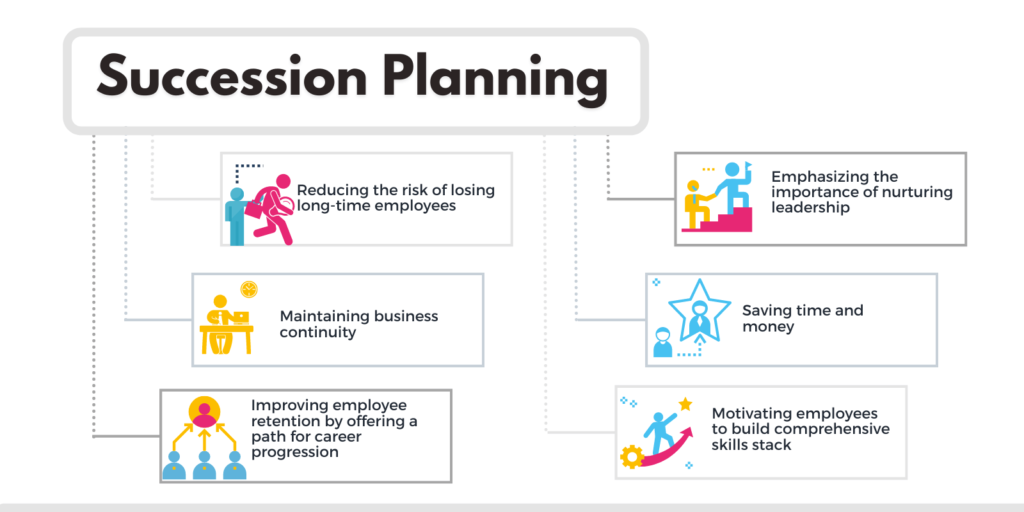
A report from Deloitte, The holy grail of effective leadership succession planning, observes: “While 86% of leaders believe leadership succession planning is an “urgent” or “important” priority, only 14% believe they do it well.”
Succession planning accomplishes a variety of objectives that help leaders reach their full potential while driving a series of benefits for the company at large. While succession planning is most often associated with developing future leaders and senior managers, it can be applied to any role within the company.
For example, certain business-critical roles which may require lengthy recruitment steps to replace will benefit a great deal from succession planning. HR leaders can adopt a targeted approach to succession planning, a generalist approach targeting a “pool” of roles, or a blended approach that encompasses a range of roles.
The benefits of effective succession planning
Well executed succession planning brings with it a range of benefits, including:
- Reducing the risk of losing long-time employees who possess critical information and expertise vital to the company’s performance.
- Maintaining business continuity and minimising disruption by filling job vacancies quickly with personnel familiar with the organisation’s structure.
- Improving employee retention, offering a clear path for career progression where leadership potential is valued.
- Emphasising the importance of nurturing leadership throughout the company and understanding where the most talented employees are.
- Saving time and money looking for external candidates to fill a role, with less recruitment costs and a streamlined onboarding process.
- Motivating employees to build a comprehensive skills stack and focus on their personal and professional development.
By using these and other methods to develop potential leaders, employees can be confident their future success is a priority for the company. A transparent succession planning process builds trust and enhances the motivation to improve.
The Process of Succession Planning in HRM
For an effective succession planning process, as an HRM, you need to do the following:
- Identify the roles that are open or will be open soon
- Review the talent for people best suited to these positions
- Improve on the skill gaps and provide leadership training
- Create a pipeline with multiple potential successors
With this proactive approach, you will ensure a smoother transition during management changes. Along with this, the executive succession planning process can be a career map for employees who want to seek a long-term career with your organisation.
Being a part of the succession planning process can act as a motivator. For the HRM, having well-trained successors in place is a must to reduce risks, and disruptions, and save on the cost of hiring new management recruits.
For better effectiveness, let’s evaluate the various approaches.
Approaches to succession planning
Effective succession planning requires a combination of data-driven insights and a people-centric approach. An objective and unbiased identification approach should be combined with a holistic approach to employee career development. Emerging leaders should be picked out from the crowd as early as possible, so their potential and ability can be nurtured.
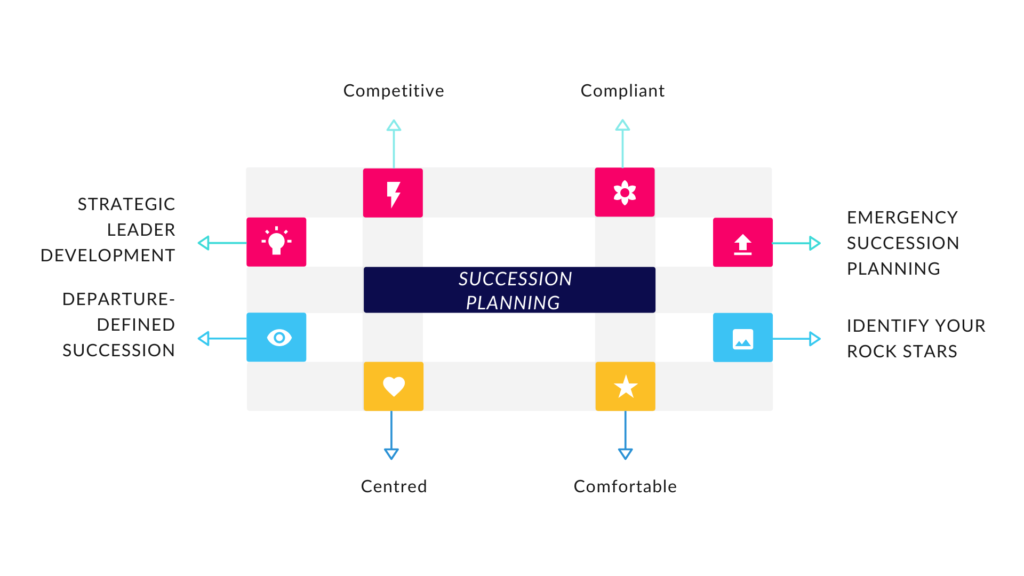
Deloitte’s report highlights four different approaches to succession planning:
- Competitive. This process-based aspect of succession planning segregates employees into “haves” and “have nots”. It gives an objective framework from which to make decisions.
- Compliant. Another process-centric aspect of succession planning, compliance is a “check-the-box” annual exercise.
- Centred. By contrast, the centred approach is empathetic and engaging while understanding the key behavioural factors involved.
- Comfortable. This approach brings trust-based decision-making to the succession planning process.
A centred and comfortable approach, to use Deloitte’s definition, is a favourable strategy for effective succession planning. This should be backed up with objective evidence around decision making.
The Deloitte report concludes: “The “holy grail” of effective succession planning turns out to be surprisingly obvious but unsurprisingly difficult: balance empathy and attention to human factors with objective decision-making and the organisational discipline to see the process through.”

There are other approaches to succession planning which some businesses adopt. These include:
Strategic leader development
Strategic leader development begins with identifying the company’s defining vision, then recruiting those who have the appropriate managerial skills to carry that vision out. This is an ongoing and proactive approach to succession planning, rather than one which reacts to a sudden void in a given leadership position.
Departure-defined succession
Whereas strategic leader development is a continual process. Departure-defined succession activates when a leader announces their resignation. At this point, the success process kicks into action, defining priorities and searching for a new leader. Typically, this approach to succession planning is carried out only for senior leadership positions.
Emergency succession planning
If a business leader dies unexpectedly, or otherwise vacates their position at very short notice, protocols for succession need to be in place. This is where emergency succession planning comes in. Roles and responsibilities are clearly defined so that continuity of business operations can be assured.
Identify your rock stars
A company’s A-players can define failure or success. Understanding which employees are – or have the potential to be – A-players is essential if business leaders want to beat their competition. These star players are worth their proverbial weight in gold, responding to complex challenges, uniting teams and departments, and being able to succeed under pressure.
These A-players are also potential future leaders, so identifying them and nurturing their talent should be a top priority. Managers and team leaders can ask several questions of their employees which can help to pinpoint who the workplace rock stars actually are.
- Have they successfully managed big projects?
- Have they been promoted at least once in the company?
- Do they demonstrate an ability to shift from one role to another notably different role?
- Are they confident and assertive without being arrogant and overbearing?
- Do they demonstrate a commitment to ongoing learning and development?
- What is their attendance record and overall commitment to the company like?
- Have they shown an ability to effectively delegate tasks to the best candidates?
Performance management software can also be used to help business leaders identify those employees best suited for leadership development. The tools available can also identify those key positions which require a thoughtful succession planning process.
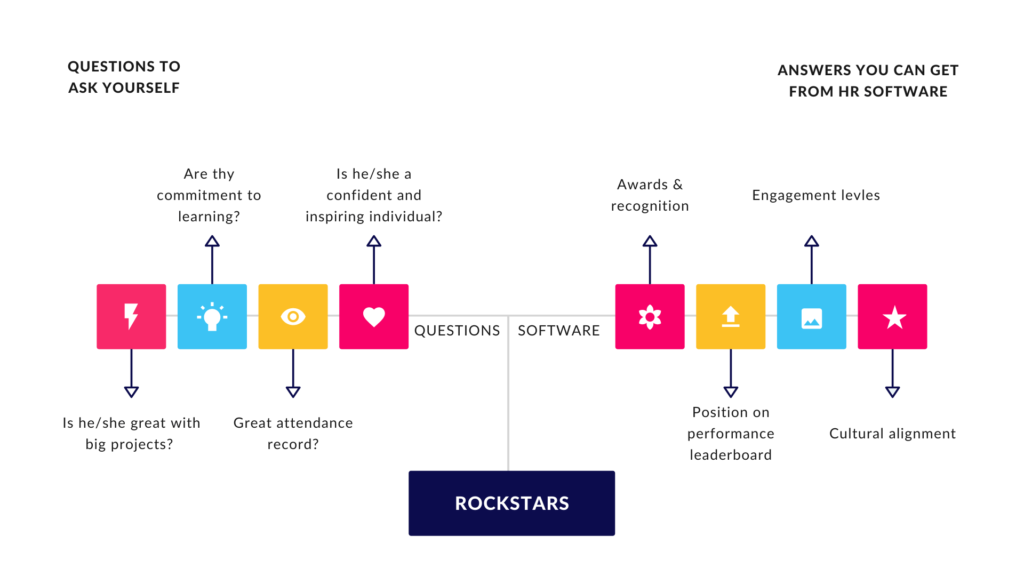
Aspects of employee performance that performance management tools can evaluate include:
- Success achieving objectives and key results (OKRs) and key performance indicators (KPIs)
- Training, qualifications and other indicators of their existing talent stack
- Absence, sickness and overtime history
- Manager-to-peer awards and recognition
- Awards and recognition from peers and colleagues
- Visual representation of employee performance and
- Cultural alignment with Success Circles (supirior to the 9 box grid method)
- Position on performance leaderboards
- Level of interaction across various communications platforms
- Analytics and reports across a range of other performance-related metrics
All the above measures can, in combination, paint an accurate picture of where talent lies within the workforce. Once these high-potential employees have been identified, they can be integrated into an overall succession planning process.
Additional Read: 10 Key Tools and Techniques for Performance Management
Nurturing internal talent
Identifying and nurturing talent sits at the core of effective succession planning. A program of talent retention complements this process. This ensures that A-players who are given the resources to develop their leadership potential don’t take those skills elsewhere.
An article for Forbes magazine outlines a variety of ways leaders can build internal talent without losing business focus. These include:
- Creating a shared vision through alignment. Aligning individual goals with organisational objectives can be achieved in a number of ways. Putting together Personal Development Plans (PDPs) can be an effective method for bringing a high performance employee’s professional aims in line with the company’s mission.
- Creating opportunities for growth through stretch assignments. Star players are at the peak of performance when their abilities are stretched to the limits. By offering them chances to work on ambitious, challenging projects, they are given additional avenues for growth.
- Communicate and coach frequently. Leadership development is an ongoing process which requires ongoing interaction to succeed. Positive feedback should flow to these employees on a daily basis, with clearly communicated objectives.
- Create a company culture which emphasises the importance of nurturing talent. One issue with succession planning can be having the perfect candidate for the role sitting right under your nose, but not realising it’s there. Employees need to be aware of the opportunities which are available to them, which includes placing the nurturing of talent front and centre in the company’s culture.
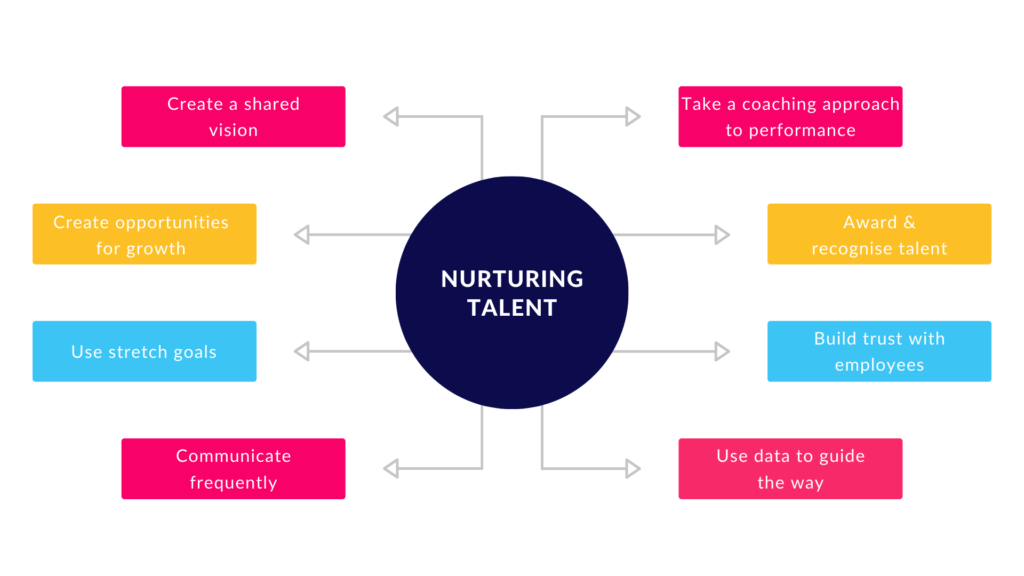
By nurturing your internal talent and developing potential future leadership, succession planning becomes a more streamlined process. When key positions need to be filled, HR leaders and managers can draw upon an internal pool of candidates who are already up to speed on what these positions entail.
Openness, fairness and diversity
As with any hiring decision-making, succession planning should be conducted openly and fairly. A merit-based approach to diversity can also be adopted, allowing employees of all genders, ethnicities and races the opportunity to grow within the company.
Diverse leadership teams can help to build confidence and motivation within an organisation, especially when these positions are appointed when based on merit rather than demographics. It shows the company recognises all talent wherever they see it, as well as a readiness to incorporate fresh perspectives.
Such diversity can also improve your company’s brand image, building a leadership team that reflects the composition of its customer base. This diversity can also help to reduce bias in decision-making processes, ensuring that potential talent within the company is identified and nurtured as broadly as possible.

Look at your entire organisation
It isn’t always necessarily obvious who the most suitable person for a leadership role is at first glance. At the same time, in large companies, the best candidate for a role might come from a completely different team or department to the one where the position needs to be filled.
This is why effective succession planning should cast a wide net and consider potential candidates from the entire organisation. HR databases and analytics can provide a useful starting point for this process.
This can include:
- Using the HR people database to create an overview of which employees might be best suited for leadership development. Such a database will also give clear information on their attendance, appraisals and a record of their training.
- Understanding where these candidates work within the company through departmental and organisational charts. By seeing which teams and departments have the best talent, decisions about succession aren’t restricted to one area of the company.
- Performance management timelines can give a clearer understanding of which employees have been improving over time. This helps to pinpoint those who are continually improving and might be most responsive to leadership initiatives.
- Employees who are highly rated by their peers, communicate clearly and effectively, and get great feedback, can be identified through HR reporting. These reports can be easily viewed through a performance management dashboard covering a wide selection of metrics.
Using 360 degree feedback to gain additional insights into potential leaders
An employee’s ability to effectively lead can often go hidden from upper management. But the colleagues they work with directly can have a unique perspective on their performance. 360-degree feedback gives business leaders and senior managers much-needed insights into these qualities.
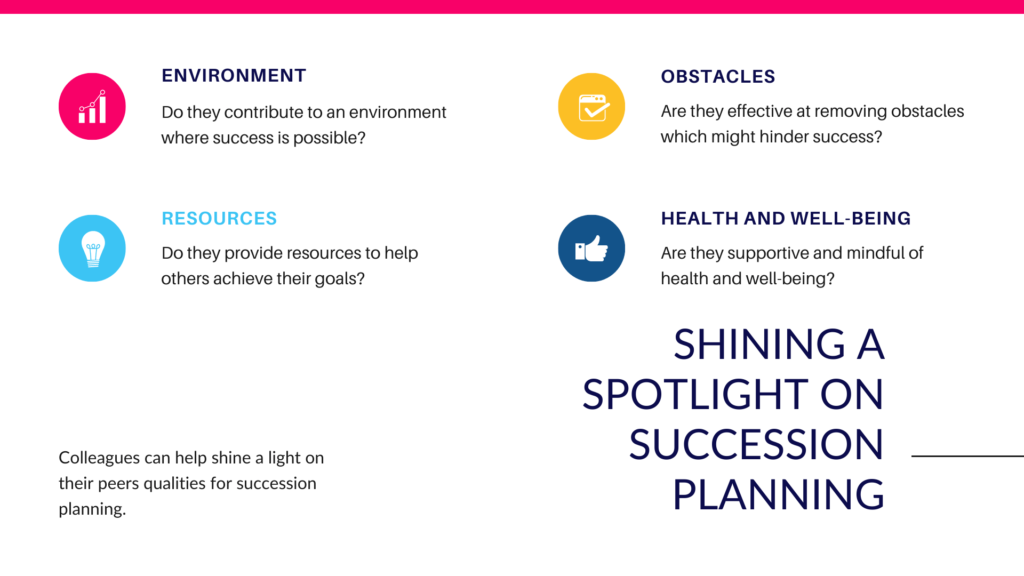
360-degree feedback is an important element of successful talent management and leadership development. Customised questionnaires can be sent to everyone who works alongside a potential leader to deliver a holistic overview of how they perform.
Such questions can include:
- Do they contribute to an environment where success is possible?
- Do they provide resources to help others achieve their goals?
- Are they effective at removing obstacles which might hinder success?
- Are they supportive and mindful of health and well-being?
- Do they consistently deliver constructive feedback?
- Is this person approachable when faced with problems?
- Do they communicate well with other employees?
Additional Read: Compact Guide to 360-degree Feedback
Frequently asked questions
What is Succession Planning and Why is It Important?
Succession planning is the process of identifying where potential future leaders exist in the company and delivering the training to prepare them for the role. While succession planning is typically used for leadership positions, other business-critical roles can also be included in the process.
What Are the Examples of Succession Planning?
The principal type of succession planning is for senior leadership positions. These are the key positions that are essential for the smooth running of the organisation at the highest level.
Non-leadership succession planning can include putting in place successors for roles vital to the organisation’s success. This can include roles with a high degree of technical understanding, and other niche roles which require specialisation.
What Are the Key Elements of Succession Planning?
Successful succession planning requires a number of key steps. These include:
- Taking a proactive position
- Understanding the requirements of the role in detail
- Identifying potential candidates
- Giving the training and resources needed to bring them up to speed
- Performing trial runs and shadowing of potential candidates
- Integrating succession planning into the company’s recruitment strategy
Why is Succession Planning Useful in HR?
HR departments typically have greater clarity regarding the organisation’s strengths and weaknesses. As such, they are in the best position to help manage successful succession planning.
They can use their internal records to map where relevant skills and experience lie, shortlisting potential leadership candidates. They can also help with cross-departmental succession planning to ensure the best candidates are selected, regardless of where they are in the company.
What is the Leadership Succession Planning Process?
Leadership succession planning requires a deep understanding of the duties and expectations in a given leadership role. By working closely with the current post holder, business leaders can build a talent pool throughout the workplace so successors are properly equipped with the skills needed for leadership positions.





